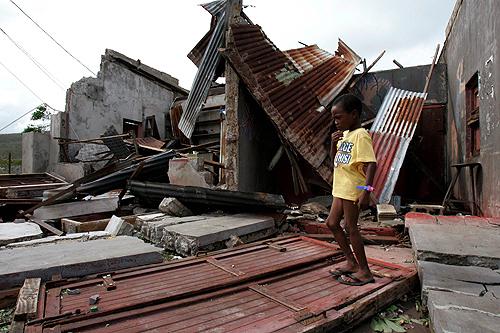Hurricane Dean heads to Mexico

A child walks by the rubble of a shop destroyed by the strong winds of Hurricane Dean in the south central village of Mitchell Town, Jamaica, on Monday. Jamaica avoided a direct hit when the storm passed to the south Sunday night and no deaths were report THE ASSOCIATED PRESS, ADRES LEIGHTON
August 21, 2007
TULUM, Mexico – Hurricane Dean headed for a collision course with Mexico’s Yucatan Peninsula on Monday, forcing the state-run oil company to abandon its off-shore rigs, and sending tourists fleeing for the airports and locals searching for higher ground. The storm killed 10 people as it crossed the Caribbean.
Dean was already a powerful Category 4 storm as it raked the Cayman Islands. The U.S. National Hurricane Center said it could grow into a monstrous Category 5 hurricane before slashing across the Yucatan Peninsula and emerging in the oil-rich Gulf of Campeche.
Mexico’s state oil company decided Monday to evacuate all 14,000 workers and shut down production on the offshore rigs that extract most of the nation’s oil.
While the storm’s center was expected to strike central Mexico, the outer bands of the storm were likely to bring rain and gusty winds to south Texas, already saturated after an unusually rainy summer. Texas officials were taking no chances; emergency operations centers opened, prison inmates were moved inland, and sandbags distributed.
The Mexican resort city of Cancun began evacuations and arranged for extra flights to help tens of thousands of tourists leave before Dean’s arrival. The hotel zone was quiet on Monday, nearly all guests gone.
Get The Daily Illini in your inbox!
Florida Volynskaya, 24, of Baltimore, arrived at Cancun’s airport Sunday planning to spend the night on the floor in hopes of getting a flight out.
“We just wanted to get out anywhere,” said Volynskaya. “We really didn’t want to be in a shelter.”
Though forecasts had shifted the projected track to the south, Cancun still could face tropical-storm-force winds, forecast to extend over an area of about 75,000 square miles, about the size of South Dakota, and local fishermen were taking precautions.
“We’re leaving. You don’t play around with nature,” Maclovio Manuel Kanul said as he pulled equipment out of his beachfront fishing shack near Cancun.
“We still haven’t been able to recover from Wilma, and now this is coming.”
Hurricane Wilma ravaged Cancun in 2005, filling hotel lobbies with shattered metal, marble, glass and muck, and reducing beaches to thin strips. The storm caused $3 billion in damage, the largest insured losses in Mexican history.
Dean, the first hurricane of the Atlantic season, bore down late Sunday on the Cayman Islands after battering Jamaica, but the vulnerable British territory said Monday it had been “spared the brunt of Hurricane Dean.”
In one Cayman shelter, the gymnasium of John Gray High School, about 100 people gathered around radios Sunday night, listening to the latest news about the hurricane.
“Whichever God you believe in, now is the time to bow your head and pray to him,” said Zemrie Thompson, the shelter coordinator. Those in the gym bowed their heads.
Dean’s eye passed some 100 miles south of the Cayman Islands, which were spared the hurricane-force winds extending up to 60 miles from the center.
Early Monday, Dean had maximum sustained winds of 150 mph, up from 145 mph Sunday, and could dump up to 20 inches of rain. Even if the hurricane continues a steady westward course toward Mexico, parts of Texas could be flooded by the storm’s outer bands.
“Our mission is very simple. It’s to get people out of the kill zone, to get people out of the danger area, which is the coastline of Texas,” said Johnny Cavazos, chief emergency director of Cameron County, at Texas’ southern tip.
Jamaica avoided the direct hit when the storm wound up passing to the south Sunday night. The storm collapsed buildings, uprooted trees, flooded roads and tore the roofs off many homes, businesses and a prison block. No prisoners escaped.
Police said officers got into a shootout with looters at a shopping center in the central Jamaican parish of Clarendon, but nobody was hurt. Curfews were in effect until Monday evening. Authorities also cut power on the island to prevent damage to the power grid.
The government set up more than 1,000 shelters in converted schools, churches and the indoor national sports arena, but only 47 were occupied as the storm moved in, said Cecil Bailey of the Office of Disaster Preparedness and Emergency Management.
George Lee, mayor of the Portmore community near the Jamaican capital Kingston, said appeals to evacuate went unheeded. Some islanders said they were afraid for their belongings if they moved to shelters.
Associated Press writers Howard Campbell in Kingston, Jamaica; Mark Stevenson in Cancun, Mexico; Michael Melia in San Juan, Puerto Rico; Evens Sanon in Port-au-Prince, Haiti; Lisa Orkin Emmanuel in Miami; and Carley Petesch in New York contributed to this report






